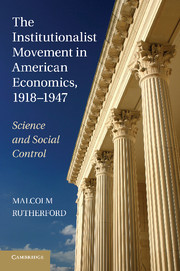Book contents
- Frontmatter
- Contents
- List of Tables
- Acknowledgments
- PART ONE INTRODUCTION
- PART TWO INSTITUTIONALIST CAREERS
- 3 Walton Hamilton
- 4 Morris A. Copeland
- PART THREE CENTERS OF INSTITUTIONAL ECONOMICS
- PART FOUR CHALLENGES AND CHANGES
- PART FIVE CONCLUSION
- Archive Collections Consulted
- References
- Index
- Titles in the series
4 - Morris A. Copeland
Institutionalism and Statistics
Published online by Cambridge University Press: 03 May 2011
- Frontmatter
- Contents
- List of Tables
- Acknowledgments
- PART ONE INTRODUCTION
- PART TWO INSTITUTIONALIST CAREERS
- 3 Walton Hamilton
- 4 Morris A. Copeland
- PART THREE CENTERS OF INSTITUTIONAL ECONOMICS
- PART FOUR CHALLENGES AND CHANGES
- PART FIVE CONCLUSION
- Archive Collections Consulted
- References
- Index
- Titles in the series
Summary
As is the case with Walton Hamilton, Morris A. Copeland's work and career has been the subject of relatively little discussion and is not well known today, even among institutionalists. As noted in earlier chapters, the standard histories of institutional economics have tended to focus on a few leading figures, notably Thorstein Veblen, Wesley C. Mitchell, and John R. Commons, and have largely ignored the many others (some of whom had outstanding careers) associated with the movement. This narrow focus has given a misleading impression both of the institutionalist movement itself and also of the nature of the institutionalist contribution to economics. Along with the previous chapter on Hamilton, this examination of Copeland's career helps correct this problem. Copeland is a perfect candidate for such a case study owing to his central place within the interwar institutionalist movement, his teachers, the contacts he maintained, his work in both academic economics and in public service, and the professional standing he achieved within economics generally. Copeland's career reveals a great deal about how the ideas of the founding group were carried over into the work of their students.
STUDENT CAREER: AMHERST AND CHICAGO
Copeland's first contact with economics was as an undergraduate student at Amherst College. As noted in previous chapters, Walton Hamilton was hired to Amherst in 1915 and Walter Stewart in 1916. They created an economics curriculum with a heavy institutionalist orientation (Hamilton 1917).
- Type
- Chapter
- Information
- The Institutionalist Movement in American Economics, 1918–1947Science and Social Control, pp. 96 - 122Publisher: Cambridge University PressPrint publication year: 2011

